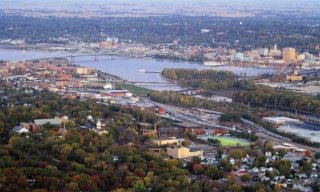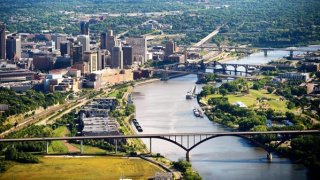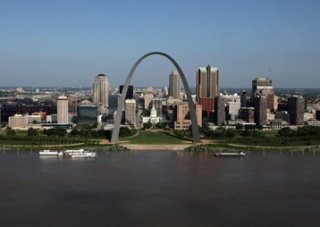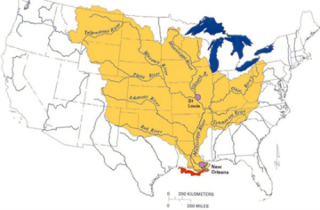Forever Connected: Rivers as a Driving Force for Partnerships
As a little girl, I grew up playing in Missouri creeks and swimming and boating at the Lake of the Ozarks. It is no surprise that I would end up living in a river city, with a degree in geology and working at the Environmental Protection Agency.
In the 24 years I've spent at EPA, I have worked in several different programs, but Region 7’s Land, Chemical and Redevelopment Division now allows me the opportunity of working with Sustainable Materials Management., I am able to still find connections to those childhood creeks and streams by fostering environmental stewardship through voluntary programs.
I first learned about microplastics at a National Trash Free Waters workshop - their impact on the environment, and how widespread they are across the globe. Microplastics are found in every water column of the oceans, from the surface to the bottom, and in the polar ice caps.
There is a direct connection between how we manage materials on land and our overall water quality; 80% of the plastics in the oceans come from sources on land.
Plastic has become a major part of our lives. Today, we only have to look around our home or office to find hundreds of different items made from plastic. The littered items we see on land and in streams range from the smallest items, like synthetic fiber in cigarette butts, to larger items like food and beverage packaging. All of this plastic material breaks into tiny pieces called microplastics, which are harmful to the environment and wildlife. Microplastics are found in the tissue of many fish species and seafood, and inside birds, turtles, and mammals that mistake the small plastic items for food.
When I find a piece of litter, I ask myself, “Why did this end up here? What prevented someone from disposing of it correctly and what would it take to get them to change?”
The search for the answers to these types of questions leads us to better understand the “people” part of the work we do at EPA, and to understand the social behaviors that overlap with environmental and economic behaviors.
Meeting People Where They Are
Imagine for a moment, a person walking in a park deciding where to put their candy wrapper, or a manager of a candy company deciding what type of wrapper to put on their product, or a park manager trying to keep a park clean of candy wrappers. All three of these individuals are connected to the same problem.
At EPA, we continue to facilitate conversations between all those connected, in order to come up with more sustainable decisions to protect our lands and waters. This means bringing together a diverse group of people at all levels to discuss what will work in a specific area and in unique situations - encouraging communities to tell us what will work for them, rather than taking action on what we think will work for them.
Rivers Connect Us and Create Partnerships

One of the recent partnerships I helped establish at EPA was with the Mississippi River Cities and Towns Initiative. The MRCTI is an amazing group of over 100 mayors of cities along the Mississippi River corridor who have united to protect the ecological health of the river.
The MRCTI uses the river to its advantage to connect the cities to common goals and reach a broader audience, while leveraging resources from many types of public and private organizations.
At the 2019 MRCTI annual meeting in Memphis, Tennessee, I heard the mayors of the MRCTI detail their commitment to reducing plastic pollution in the Mississippi River corridor.
With the help of the United Nations Environment Programme and the University of Georgia, the MRCTI has completed successful citizen science projects in four cities or regions along the river: St. Paul, Minnesota; St. Louis; Quad Cities region of Iowa and Illinois; and Baton Rouge, Louisiana. (A fifth project is underway in Greenville and Rosedale, Mississippi.)

These projects gathered hundreds of volunteers in each community to establish a baseline and record the quantities, types, and location of plastic and other litter in their communities, using the National Oceanic and Atmospheric Administration (NOAA) Marine Debris Tracker. Their final report showed that 75% of the items tracked in each city were made from plastic, along with many other key issues that we are hoping to understand more fully.
These projects also sparked community involvement and brought people from many different backgrounds together on a common goal, with the mayors leading the way. The success of these projects makes it clear that people are eager to tackle the plastic pollution problem in their beloved Mississippi River.
Working Together for a Cleaner Future

Just as cities in the upper Mississippi River basin can connect with cities in the lower river basin, EPA can connect across regions on our shared goals and magnify the results and successes geographically. EPA has a mechanism for partnering with agencies and organizations on common goals called Memorandums of Understanding (MOUs).
The Office of Resource Conservation and Recovery, and Office of International and Tribal Affairs, and a team comprised of staff from EPA Regions 4, 5, 6, and 7 set out on a journey to create the first multi-regional Memorandum of Understanding with MRCTI.
The goals of the MOU were to engage with stakeholders; provide technical assistance to support plastic pollution prevention and sustainable management of materials; and share knowledge using a community-driven approach.
I’m proud to say that the MOU was signed by EPA Deputy Administrator Janet McCabe and the MRCTI on Sept. 16, 2021.
During the signing of the MOU, Deputy Administrator McCabe summed it up perfectly when she said, “It’s the mayors and their staff who get things done in this country. They have the best ideas and know what needs to be done and what has been successful in their communities.”

The Mississippi River flows through 10 states and four EPA Regions. It spans an even larger area if you consider all the tributaries that feed into it, like the Missouri, Illinois, Ohio, Arkansas, and Red Rivers, bringing Regions 3 and 8 into our partnership. No other watershed in the United States connects as many diverse cultures and people as the Mississippi River does in the heartland of America.
Regions 4, 5, 6, and 7 are committed to begin working with the Mississippi River cities to reduce plastic pollution in the main artery in the heart of our country. Only by working together can we hope to protect our waterways for future generations to enjoy the way I did as a child.
Learn more about Mississippi River Plastic Pollution:
- EPA Formalizes Local-Federal Partnership to Protect Mississippi River Communities from Plastic Pollution
- EPA Microplastics Research
- Mississippi River Cities and Towns Initiative (MRCTI)

About the Author
Gayle Hubert
Sustainable Materials Management and Sustainability Coordinator
Land, Chemical and Redevelopment Division, Region 7
Gayle began her career at EPA in 1997 in the RCRA Corrective Action and Permitting program. She currently is the sustainability coordinator in Region 7, which includes Iowa, Kansas, Missouri, Nebraska, and nine Tribal Nations. She collaborates with states, local governments, recycling organizations, and other partners to reduce waste, reuse and recycle materials, and develop strategies for reaching sustainability goals. Gayle is always eager to make things happen for communities. Before joining EPA, she was a geologist for several environmental consulting firms for Superfund and RCRA government contracts. In her spare time, Gayle enjoys playing pickle ball, hiking, birdwatching, gardening with native plants and trees for pollinators, and watching her favorite sports teams: Kansas City Royals, Kansas City Chiefs, Missouri Tigers, and Kansas Jayhawks. She lives in the river town of Parkville, Missouri, in the Kansas City area.
Editor’s Note: The views expressed here are intended to explain EPA policy. They do not change anyone’s rights or obligations. You may share this article. However, please do not change the title or the content, or remove EPA’s identity as the author. If you do make substantive changes, please do not attribute the edited title or content to EPA or the author.
EPA’s official web site is www.epa.gov. Some links on this page may redirect users from the EPA website to specific content on a non-EPA, third-party site. In doing so, EPA is directing you only to the specific content referenced at the time of publication, not to any other content that may appear on the same webpage or elsewhere on the third-party site, or be added at a later date.
EPA is providing this link for informational purposes only. EPA cannot attest to the accuracy of non-EPA information provided by any third-party sites or any other linked site. EPA does not endorse any non-government websites, companies, internet applications or any policies or information expressed therein.
